A380 engine failure: Qantas claims 'faulty design'
Loading...
| SYDNEY, Australia
Qantas' chief said Friday a design fault or mechanical failure was probably what caused an engine on one of its Airbus A380s to blow out as it took off, prompting an emergency landing and worldwide safety inspections of the superjumbos.
International air safety officials are investigating what caused the engine failure that ripped metal on the left wing, littered debris on the ground far below and prompted the most serious safety scare yet on the world's largest and newest airliner.
As the more than 400 passengers from the stricken plane arrived in Australia on new flights, investigators and Qantas officials said it was far too early to identify the cause of the problem.
But Qantas CEO Alan Joyce told a news conference that the national carrier believed the plane's Rolls-Royce-made engine was at fault, not the level of maintenance to the plane.
"This is an engine issue and the engines have been maintained by Rolls-Royce since they were installed on the aircraft," Joyce told a news conference in Sydney. "We believe this is probably most likely a material failure or some type of design issue. We don't believe this is related to maintenance in any way."
One of the A380's four engines blew out about four minutes after the Sydney-bound plane took off from Singapore on Thursday, shooting flames and shedding pieces of metal over Indonesia. The engine was quickly shut down and the plane made a safe landing in Singapore after dumping its fuel.
Joyce confirmed, however, that another engine failed to shut down after the plane landed. He said the exact cause of that problem was not known, but that it was believed the blowout somehow affected the other engine.
Removing the passengers from the plane was delayed while safety officials sprayed the damaged engine with fire retardant, amid apparent fears the running engine could set leaking fuel ablaze.
Qantas grounded its fleet of six A380s, and Singapore Airlines also took its A380s out of service until safety checks were made. Singapore Airlines said it resumed its A380 flights Friday after being satisfied of their safety.
Airbus, the aircraft's manufacturer, said in a statement Friday it has asked all airlines operating A380 planes with Rolls-Royce engines to carry out safety inspections "to ensure continuous safe operations of the fleet."
Airbus has delivered a total of 37 A380s since its debut in 2007. Thirteen are in service with Emirates, 11 with Singapore Airlines, six with Qantas, four with Air France and three with Lufthansa.
Rolls-Royce is the manufacturer of the Trent 900 engines on A380 jets operated by Qantas, Singapore Airlines and Lufthansa. A380s flown by Emirates and Air France use different engines.
Shares in Rolls-Royce Group were down 8 percent Friday on the London stock exchange.
The European Aviation Safety Agency has issued orders, called Airworthiness Directives, twice this year advising airlines about potential problems with the Trent 900 and what extra inspections or repairs need to be carried out to maintain European safety standards.
Joyce said such directives are commonplace — an airline could receive 100 per year across a range of planes — and that Qantas was in full compliance with them.
"Airworthiness directives are there to try and improve the performance of ... how the maintenance is taking place — it is not unusual," he said. "If it was unusual we would be signaling that."
The Qantas problem was the most serious midair incident involving the double-decker A380 since it debuted in October 2007 with a Singapore Airlines flight to Sydney — the same route Qantas flight QF32 was flying when the engine failed.
Ian Sangston, the general manager of air safety investigation at the Australian Transport Safety Bureau, said his group would lead the official investigation, which would include input from Qantas, Airbus, Rolls-Royce and aviation authorities in several countries.
The faulty engine was being removed for inspection and the rest of the plane was being examined, too, he said. The flight data and cockpit voice recorders had been recovered and brought to Australia, where their contents would be analyzed.
Key clues to what happened, and why, would likely come from the debris that was scattered across Batam island in Indonesia when the blowout occurred. No one was injured by the falling material, which included more than 100 pieces, some as large as doors.
"We've got to gather those items from Batam, which will probably prove very interesting to our technical people as in they will show fracture surfaces and so on," Sangston told a news conference.
The agency will issue a preliminary report by Dec. 3, though the full investigation could take one year, Sangston said.





